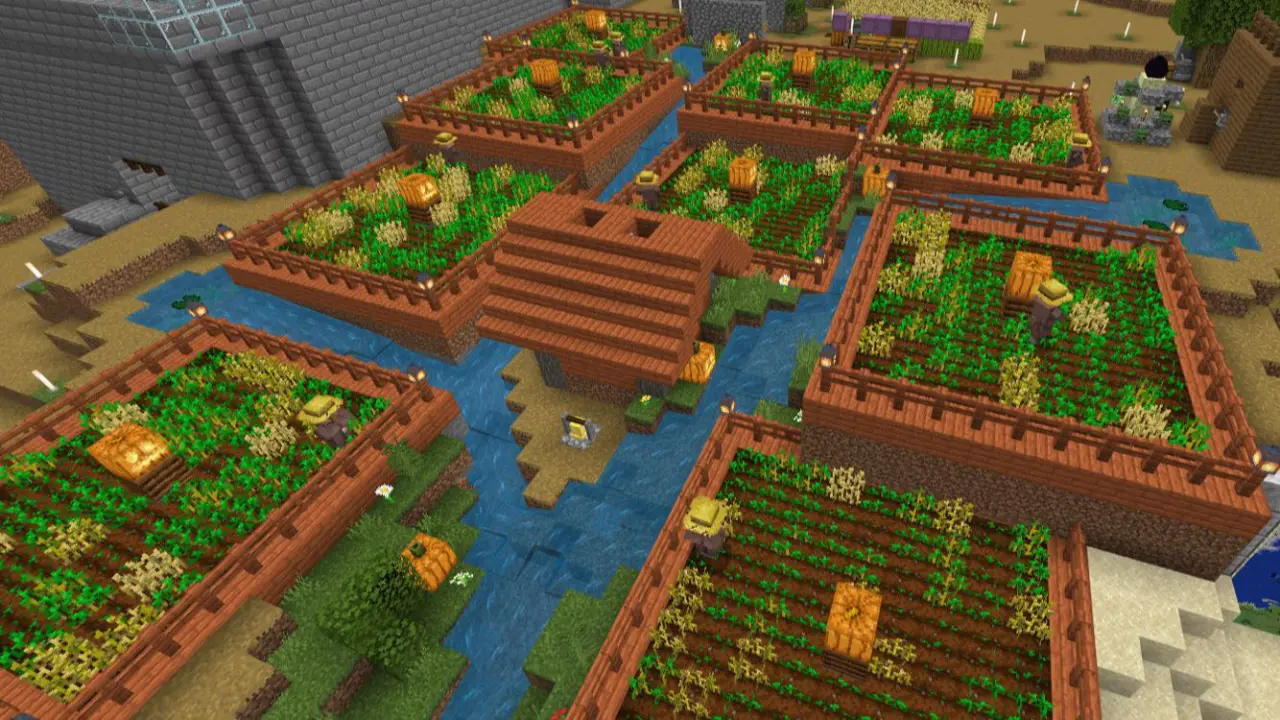You start with a humble patch of dirt, a few seeds, and a hoe. It works. But then comes the inevitable: you forget to harvest, your wheat grows unevenly, and you spend ten minutes chasing a potato you dropped in a water stream.
Let’s fix that. Automatic crop farms do the work for you — collecting, replanting, and even sorting your harvest while you go mining or build something cooler.
There are two main styles: villager-based and redstone-based. Both are worth knowing.
Option 1: Villager-based crop farms
These are surprisingly simple, fully automatic, and totally survival-friendly.
How it works
Farmer villagers are hardcoded to:
- Harvest and replant crops within a work radius
- Share excess food with nearby villagers
You can trick them into doing both — and collecting the food for you.
What you need
- 1 farmer villager (any unemployed villager + composter)
- 1 second villager inside a holding cell (they don’t need a job)
- A 9×9 farmland area (water in the middle)
- Fence or walls
- Hopper + minecart or hopper setup to collect items
Basic steps
- Build a 9×9 farm, hydrate the center with a water block
- Fence it to keep mobs out
- Place a composter in the corner — this gives your villager a profession
- Trap a second villager on the outside edge of the farm, behind a barrier
- The farmer will toss crops toward the second villager, and you collect them via hopper
What it produces
- Carrots
- Potatoes
- Wheat (slightly trickier due to seeds)
- Beetroot (least efficient, but works)
No redstone required. Just villagers and patience.
Option 2: Redstone-powered crop farms
Want more control, instant harvesting, and something that goes clunk when it runs? Redstone is your friend.
Most common version: semi-auto piston harvester
This farm doesn’t replant crops, but it harvests all of them at once with the push of a button.
What you need
- Rows of farmland
- Sticky pistons or regular pistons
- Observer blocks (for some designs)
- Redstone dust
- Water streams or hoppers for collection
- Lever, button, or Redstone clock
How it works
- Crops grow normally on tilled farmland
- You activate a piston system that floods or crushes the crops
- Water pushes the drops into a hopper or chest
- You manually replant (unless paired with villagers)
It’s neat, satisfying, and makes harvesting way less annoying.
Upgrade options
- Add Redstone timers or daylight sensors for automatic triggers
- Pair with villagers for replanting
- Use bone meal dispensers for fast growth cycles
You can even stack the whole setup vertically if you’re low on land space.
What crops work best in auto farms
- Carrots and potatoes – no seeds needed, easy for villagers
- Wheat – requires replanting seeds, a bit more fussy
- Pumpkins and melons – use observers and pistons
- Sugarcane – automatic with observers, zero replanting
- Bamboo – same as sugarcane, great for fuel farms
These setups also feed into composters, trading halls, or XP generators depending on how wild you want to get.
Common mistakes to avoid
- Forgetting to add light — crops need it to grow
- Placing water sources incorrectly — only one block hydrates 4 in every direction
- Letting villagers out — they will wander off, forever
- Overcomplicating it too early — start simple, expand later
Let the system evolve as you play. Most farms don’t start as perfect builds — they grow with your world.






